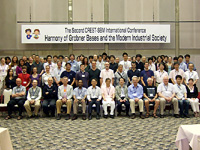The Second CREST-SBM International Conference “Harmony of Gröbner bases and the modern industrial society” was held from June 28 (Monday) to July 2 (Friday), 2010, at the Hotel Hankyu Expo Park (Suita City, Osaka). The total number of participants was 75 (34 from overseas), thus making it not only an international but also a rather lively conference. The breakdown of the foreign participants was as follows: 15 from the U.S.A., 4 from the U.K., 3 from Canada, 3 from Germany, 2 from Italy, 2 from France, 1 from Israel, 1 from Spain, 1 from Hungary, 1 from Czech, and 1 from Zimbabwe. The breakdown of the number of lecturers was 30 invitational (for 40 minutes) and 18 general (for 20 minutes). All 30 of the invitational lecturers were from overseas: Consisting of young researchers and postdoctoral fellows as well as famous researchers, all of whom were selected from a mixture of generations from young researchers through to older experts. The breakdown of the general lectures included 16 being made by domestic participants and 2 from overseas. JST as the host was at first most concerned about any possible changes or cancellations of programs due to force majeure leading to flights with a number of invitational lecturers from overseas aboard being cancelled; however, fortunately none of the lectures were cancelled after the abstract had been printed and the conference ended up going very smoothly to plan.

The overall schedule of the conference was as follows: The first day started with an opening speech made by Osamu Ichimaru, the senior chief researcher of JST, which was followed by 10 invitational lectures (4 in the morning and 6 in the afternoon), and then a welcome party was held in the evening. On the second day 4 invitational lectures were made in the morning and then 18 general lectures (short communications) from the afternoon through to the night. The third day involved four invitational lectures in the morning. On the fourth day 8 invitational lectures (4 in the morning and 4 in the afternoon) were made and then a banquet was held in the evening. On the last day the conference was closed with a closing speech made by a representative researcher after 4 invitational lecturers had delivered lectures in that morning. All the lectures were videotaped and will be made available via the website of the team.
The invitational lectures were grouped into 7 on theory, 13 on applications, and 10 on calculations. The theoretical lecture topics involved the toric ideal, the Hilbert function, convex algebraic geometry, the toric fiber product, quadratic Gröbner bases, etc. The application lecture topics involved contingency table analysis, graphical models, sparse data analysis, the design of experimental methods, Markov chains, etc. The calculation lecture topics involved the calculation D module, tropical geometry, algebraic-numeric hybrid computation, etc. At a meeting to determine the overall program of the lectures the attempt was made to organically disperse the lectures into the different fields of theory, application, and calculations in order to promote international communication between respective theoretical/applied/calculation research groups, with an interim program having been available on the website since April. The result of the aforementioned dispersion was that many of the invitational lecturers made presentations that were highly conscious of the audience not only consisting of people from their own field but also from other different fields, which, as a matter of course, then resulted in the participants being interested in lectures on topics other than from their own particular field of interest. Most of the participants therefore attended almost all the lecturers and were involved in active question and answer sessions held after the lectures, and thus the atmosphere of the conference had a cooperative spirit between the different fields. The invitational lecturers from overseas very much admired that type of collaborative attitude, as seen in particular at the welcome party and the banquet. The conventional type of international conference where lectures from a specific group usually take place on the same day cannot provide that kind of atmosphere. However, it is also important to keep in mind that the collaborative atmosphere was not just the fruit of the order of the program being taken into consideration, and that part of the background to that was also the CREST team having actively participated in international conferences, international research meetings, workshops, etc in the U.S. and European countries in promoting the research activities of the CREST team there too. For the above reasons we attempted to avoid any parallel sessions with general lecturers (short communications), which then lead to the session being quite long at from 1:30 p.m. to 9:00 p.m. Nevertheless, many of the participants also attended the lectures, something which was really very notable.
The stimulation provided by the variety of lectures made by the invitational lecturers and the mutual understanding that arose between the respective theory/application/calculation groups in the CREST team is sure to lead to further evolutions taking place. The idea of the Gröbner bases was first seen in a paper published by F. S. Macaulay in 1927; however, its modern definition was also independently introduced by Heisuke Hironaka in 1964 and Bruno Buchberger in 1965. 2014 will also be the 50th anniversary of the Gröbner bases first being discovered, in memory of which the CREST team is preparing for an international conference entitled “Recent Trends with the Gröbner bases (tentative title)” in January 2014.
JST, an integrated organization of science and technology in Japan, establishes an infrastructure for the entire process from the creation of knowledge to the return to the society. For more information, visit http://www.jst.go.jp/EN/